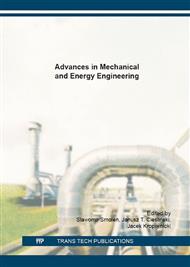[1]
Directive of European Parliament 2010/75/UE of 24 November 2010 on industrial emissions, Official Journal of EU L334/17, 17. 12. (2010).
Google Scholar
[2]
Bartela Ł., Skorek-Osikowska A., Kotowicz J.: Economic analysis of a supercritical coal-fired CHP plant integrated with an absorption carbon capture installation. Energy 64 (2014) 513-523.
DOI: 10.1016/j.energy.2013.11.048
Google Scholar
[3]
Wójs K., Polko K., Lichota J.: Condensing heat exchange design, Rynek Energii 100, 2012, 101-113 (in Polish).
Google Scholar
[4]
Rennings K., Markewitz P., Vögele S.: How clean is clean? Incremental versus radical technological change in coal-fired power plants, J. Evol. Econ. 23 (2013) 331–355.
DOI: 10.1007/s00191-010-0198-9
Google Scholar
[5]
Mikielewicz D., Mikielewicz J.: Utilisation of bleed steam heat to increase the upper heat source temperature in low-temperature ORC. Archives of Thermodynamics 32, 2011, 57-70.
DOI: 10.2478/v10173-011-0013-5
Google Scholar
[6]
Espatolero S., Cortés C., Romeo L.M.: Optimization of boiler cold-end and integration with the steam cycle in supercritical units, Applied Energy 87 (2010) 1651–1660.
DOI: 10.1016/j.apenergy.2009.10.008
Google Scholar
[7]
Stępczyńska K., Łukowicz H., Dykas S.: Calculations of ultra-supercritical coal fired 900 MWe power unit of with waste heat recovery, Archiwum Energetyki, vol. 62, 155-164 (2012) (in Polish).
DOI: 10.2478/v10173-011-0018-0
Google Scholar
[8]
Pawlik M., Kotlicki T.: Innovative coal technologies for CO2 emissions limits, Rynek Energii 94, 2011, 60-68 (in Polish).
Google Scholar
[9]
Angelino G., Invernizzi C., Molteni G., The potential role of organic bottoming Rankine cycles in steam power stations, Proc. IMechE, vol. 213 Part A, 75-81, (1999).
DOI: 10.1243/0957650991537446
Google Scholar
[10]
Aspen Plus 11. 1 User Guide. Aspentech (2001).
Google Scholar
[11]
The reference cycle for the activities within the Strategic Project Contract SP/E/1/67484/10, Institute of Machinery and Power Equipment, Silesian University of Technology, (2011).
Google Scholar
[12]
Tchanche B.F., Papadakis G., Lambrinos G., Frangoudakis A., Fluid selection for a low-temperature solar organic Rankine cycle, Applied Thermal Engineering, 29 (2009), 2468-2476.
DOI: 10.1016/j.applthermaleng.2008.12.025
Google Scholar
[13]
Andersen W.C., Bruno T. J, Rapid screening of fluids for chemical stability in Organic Rankine Cycle applications, Industrial and Engineering Chemistry 44 (2005) 5560–5566.
DOI: 10.1021/ie050351s
Google Scholar
[14]
Saleh B., Koglbauer G., Wendland M., Fischer J., Working fluids for low-temperature organic Rankine cycles, Energy, 32, 1210-1221, (2007).
DOI: 10.1016/j.energy.2006.07.001
Google Scholar
[15]
Maizza V., Maizza A., Unconventional working fluids in organic Rankine-cycles for waste energy recovery systems, Applied Thermal Engineering, 21, 381-390, (2001).
DOI: 10.1016/s1359-4311(00)00044-2
Google Scholar
[16]
Wei D., Lu X., Lu Z., Gu J., Performance analysis and optimization of organic Rankine cycle (ORC) for waste heat recovery, Energy Conversion and Management 4 (2007) 1113–1119.
DOI: 10.1016/j.enconman.2006.10.020
Google Scholar
[17]
Hung T.C., Waste heat recovery of organic Rankine cycle using dry fluids, Energy Conversion and Management 42 (2001) 539–553.
DOI: 10.1016/s0196-8904(00)00081-9
Google Scholar
[18]
Borsukiewicz-Gozdur A., Influence of heat recuperation in ORC power plant on efficiency of waste heat utilization, Archives of Thermodynamics, 31(4), (2010) 111-124.
DOI: 10.2478/v10173-010-0032-7
Google Scholar
[19]
Liu B.T., Chien K.H., Wang C.C., Effect of working fluids on organic Rankine cycle for waste heat recovery, Energy 29 (2004) 1207–1217.
DOI: 10.1016/j.energy.2004.01.004
Google Scholar
[20]
Mikielewicz D., Mikielewicz J.: A thermodynamic criterion for selection of working fluid for subcritical and supercritical domestic micro CHP. Applied Thermal Engineering (30), 2010, 2357-2362.
DOI: 10.1016/j.applthermaleng.2010.05.035
Google Scholar


